Oklahoma Center for Therapeutic Sciences Drug and Target Discovery High Throughput Screening Facility Equipment and available assay formats for HTS
High Throughput/ High Content Imaging (Fixed and Live Cell Assays)
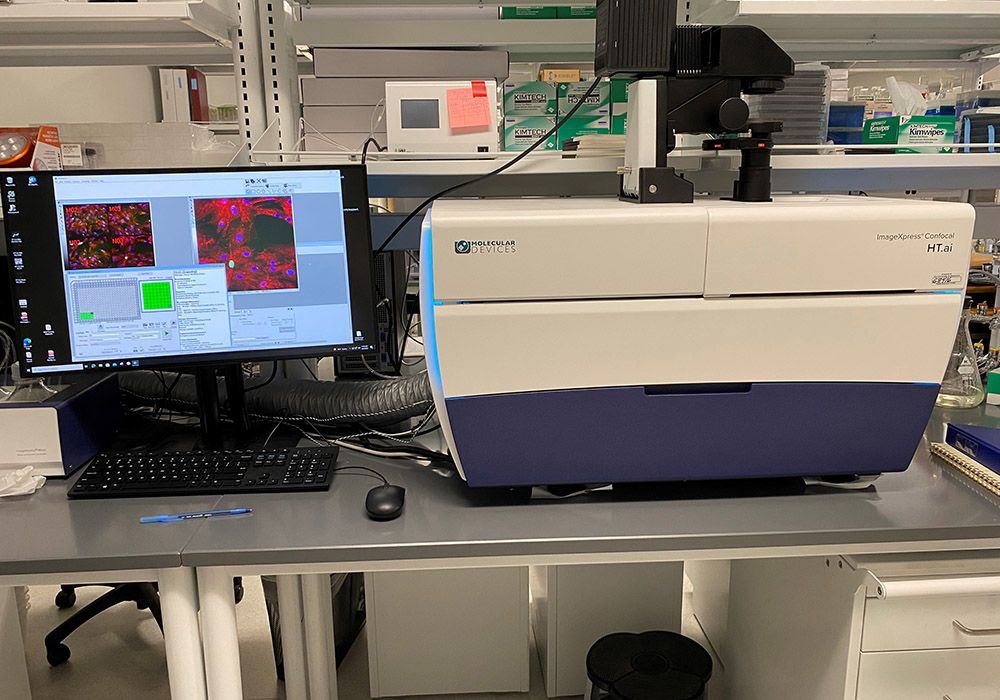
Molecular Devices ImagXpress Confocal High-Content Imaging System
- 7-channel laser illumination source (405/445/475/520/555/640 and 730nm)
- Filters for 8-channel detection (DAPI, CFP, FITC, YFP, TRITC, TxRed, Cy5, CY7)
- 4X, 10X, 60X air objectives
- 20X and 40X water immersion objectives
- Micro lens confocal launcher
- Environmental control chamber (temperature and CO2).
- Rapid microscopic analyses of a wide variety of cell behaviors.
- Spheroid and organoid imaging
- MetaXpress Imaging and Analysis Software:
- Enables selection of standard image analysis routines or development of custom protocols for specific image analysis needs.
- Provides a wide range of tools to automate image acquisition, processing, and image analyses
- IN Carta software for multidimensional image analysis:
- Robust segmentation of any biological structure
- AI powered data analytics for the identification of phenotypic changes in complex datasets and StratomineR hierarchical clustering software.
- 3D analysis of spheroid and organoid cultures
Molecular Devices FLIPR Penta High Throughput Cellular Screening System
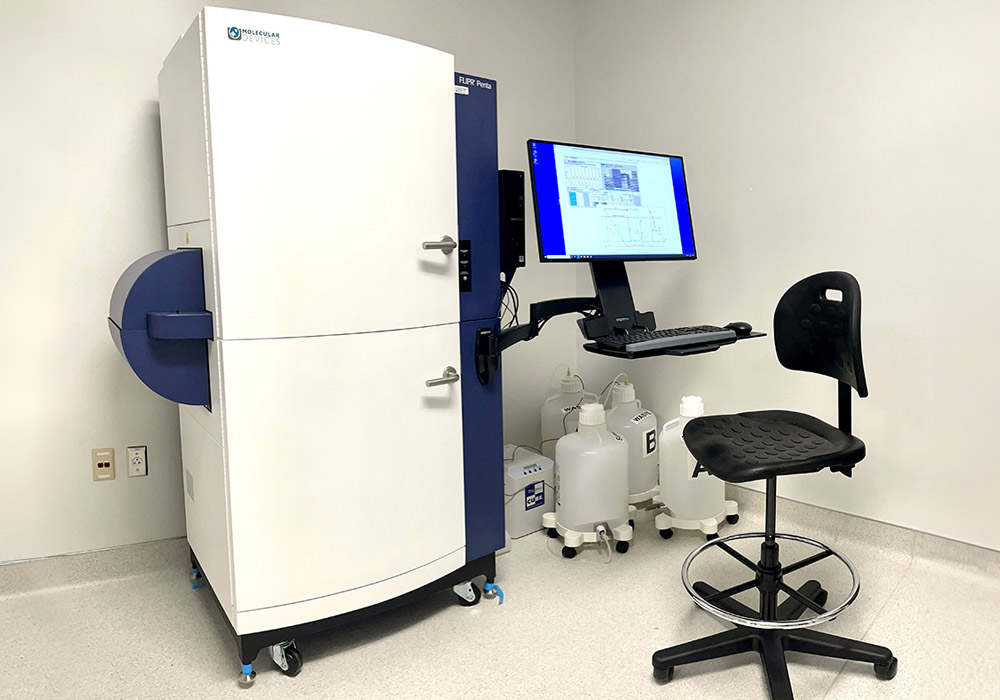
- High-throughput kinetic screening of compounds in primary HTS, or in toxicology studies for lead compound identification.
- HS-EMCCD rapid, high-definition camera- allows for recordings at up to 100 measurements per second, using fluorescent or luminescent readouts for whole plate imaging
- LED excitation light source with wave length offerings that range from 335 nm to 626 nm.
- On-board dispensing into 96-, 384- and 1536-well microplates
- Rapid kinetic assays that allow for primary screens targeting:
- G-protein coupled receptors (GPCR) and ion channels.
- Intracellular and organelle-specific calcium changes
- Changes in mitochondrial membrane potential,
- Protein localization and protein-protein interactions
- Proximity based assays: FRET and BRET
- cAMP, cGMP measurements
- Cardiotoxicity assays
High Throughput Biochemical/Gene Expression Screens
BMG Labtech Pherastar FSX multimode plate reader:
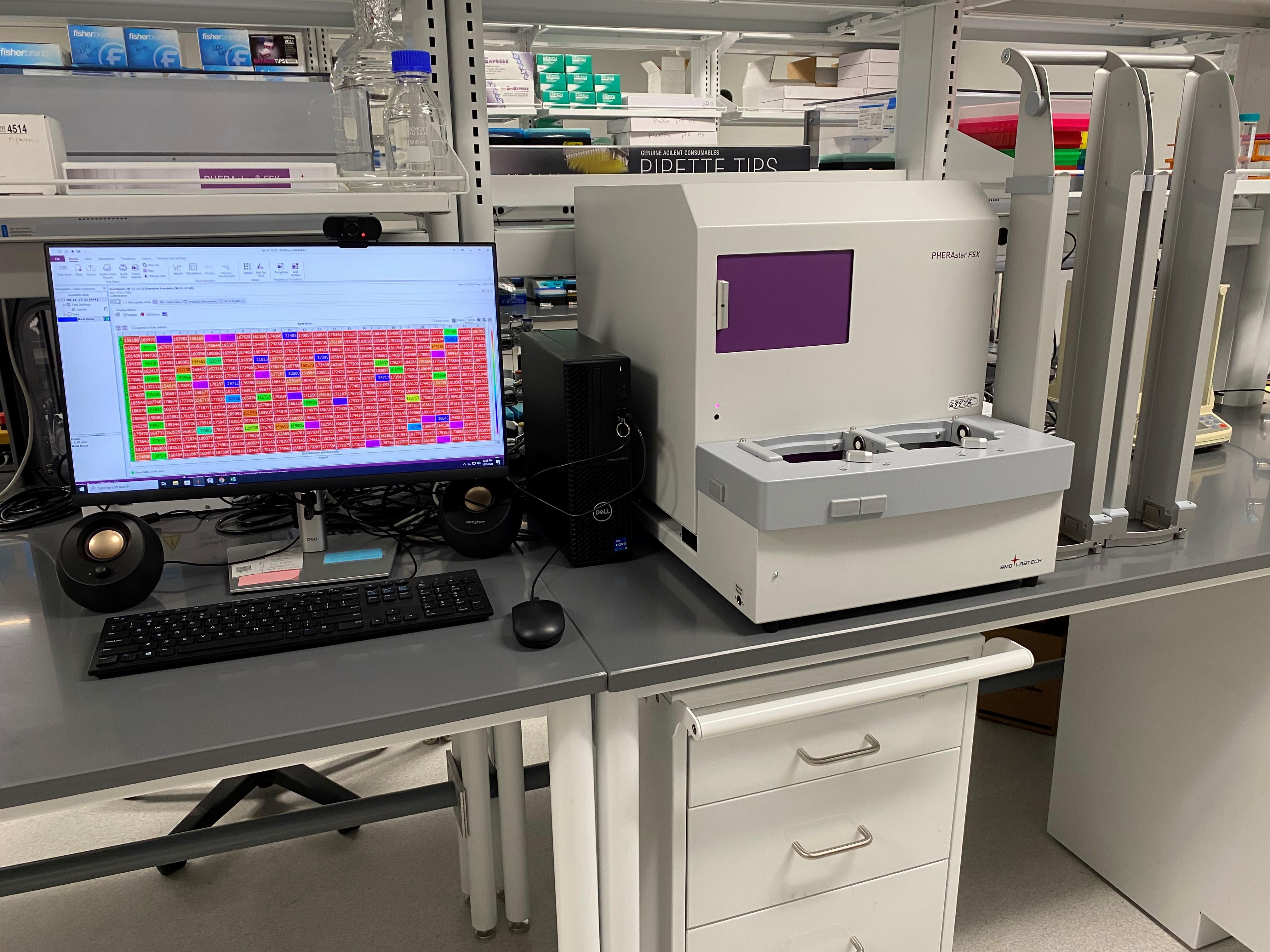
- Measurement capabilities include fluorescence intensity, fluorescence polarization, time resolved fluorescence, BRET, TR-FRET proximity-based assays, AlphaScreen, luminescence
- Assays formats for enzymatic activity, protein-protein interactions, small molecule or peptide binding, cell viability and gene reporter screens
- Capability for simultaneous injection of reagents and measurement, for highly precise kinetic measurements.
- Sophisticated user-friendly analysis software is also available. In addition, this analysis software is freely available from BMG Labtech and thus allows users to analyze data on their own computers.
- 40 microplate Plate-stacks for high throughput screening.
BMG ClarioStar multimode plate reader:
- Measurement capabilities include fluorescence intensity, luminescence, absorbance
- The CLARIOstar Plus is equipped with two linear viable filter monochromators (320-740nm), one for excitation and one for emission. A Linear Variable Dichroic mirror (340-740nm) separates the excitation and emission light. This configuration combines the sensitivity of filters with the flexibility of a monochromator.
- The spectrometer can measure a full UV/Vis spectra ranging from 220nm to 1000nm
- The ClarioStar also comes with a low volume plate that allows for small volume (1ul-3ul) absorbance and fluorescence measurements.
- ClarioStar can accommodates 6-well to 384-well microplate formats and can perform top and bottom reads.
- ClarioStar includes temperature control up to 450C, plate shaking.
- Includes two injectors for initiating kinetic and enzymatic assays.
High Throughput Measurements of Biomolecular Interactions
Sartorius OCTET RH16 Biolayer Interferometry (BLI):
BLI is an optical biosensing technology that analyzes the kinetic parameters which govern biomolecular interactions. Fluorescent labeling of regents is not required. BLI allows for the rapid determination of on- and off-rates and equilibrium binding constants. The OCTET RH16 can accommodate 96- and 384-well microplate formats
Biolayer interferometry. Measures changes in the interference pattern between light waves of samples without and with analyte.
The light waves are reflected from layer at the end of the biosensor surface and an internal reference layer.
Reflection of light changes is a function the molecular layer thickness, i.e. the number of molecules bound to the biosensor surface.
Kinetic measurements can be applied to:
- Protein - protein interactions
- Protein - small molecule interactions
- Virus-like particle - protein binding
- DNA/RNA aptamer binding
- Glycan – protein binding
- GPCR-Protein binding
Screening Applications
- Small molecule screening
- Secondary screening and hit validation
- DNA-DNA mismatch detection
- Protein/peptide/small molecule inhibition
Provides measures of on-rates, off-rates and equilibrium binding constants
Microscale Thermophoresis (MST):
MST is capillary-based system the uses infrared light to create a thermal gradient. Fluorescent molecules migrate in the thermal gradient in a specific pattern. When the fluorescent molecule forms a complex with another molecule (ions, protein, DNA, RNA, small molecules), its thermophoretic properties change and can be quantified allowing for the determination of equilibrium binding constants.
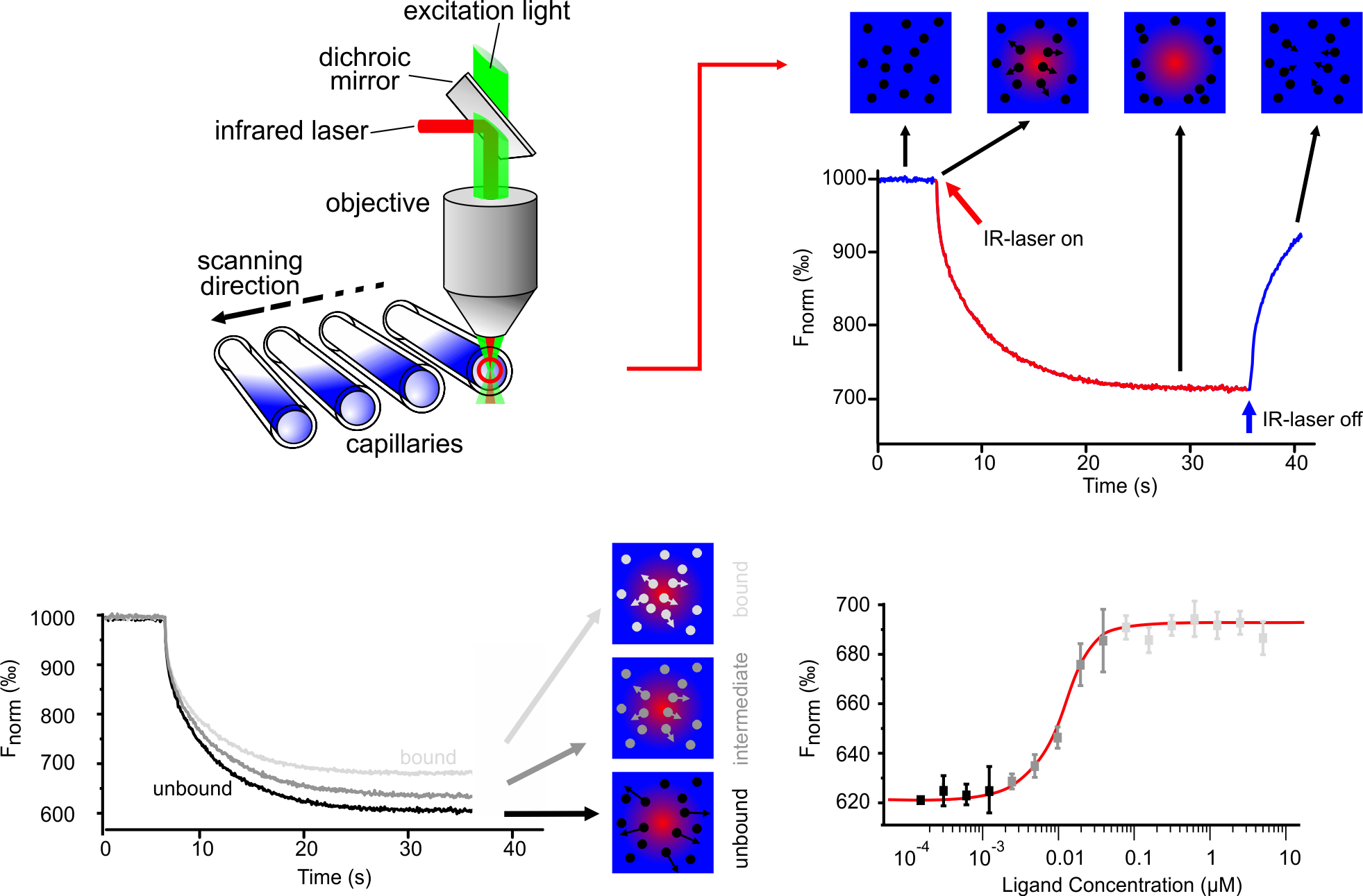
Chemical Library Plating And microplate assay development
Agilent Bravo Liquid Handling system:
- Compound plating and reagent dispensing.
- Volumes ranging from 0.4 ml to 70 ml/well into multiple plates (96-, 384-well microplates
Automated Beckman Echo-650 Acoustic Dispenser
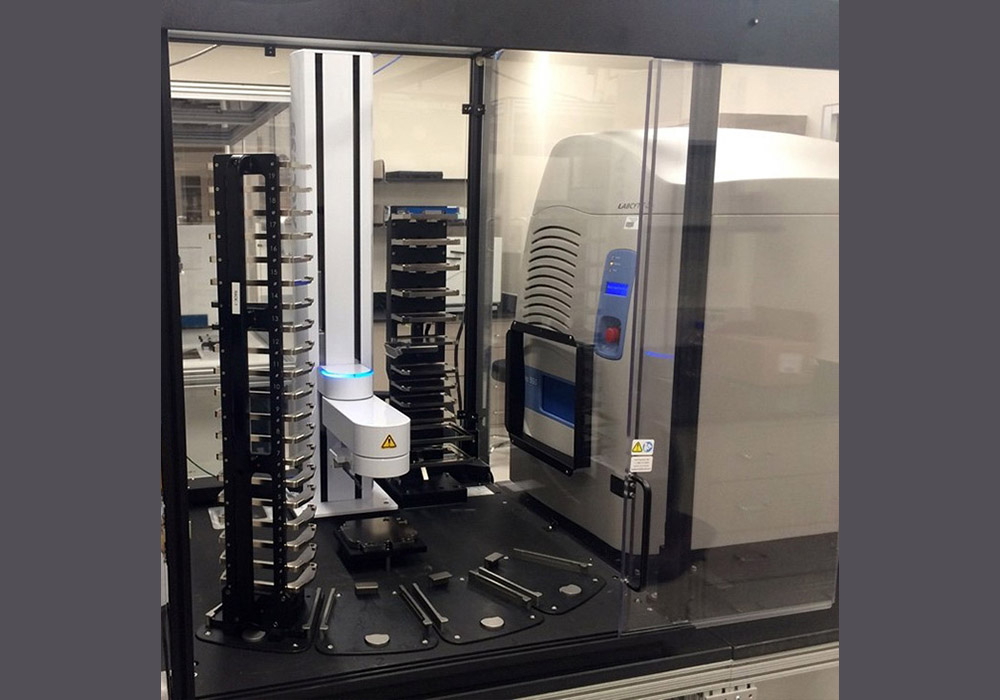
- Arrayed sgRNA CRISPR library and small molecule compound plating and reagent dispensing
- Nanoliter-scale reagent dispensing with volumes ranging from 10nl to 200nl into 384-well and 1536-well microplates.
- Tipless transfer, resulting in dramatic cost savings
- Improved information about sample integrity and improved transfer quality through the measurement of DMSO or aqueous buffer levels.
- Elimination of sgRNA or compound loss, cross-contamination, carryover, or leachates through non-contact transfer.
- Extends library lifetime through miniaturization of assays.
- Greatly simplified assay development and dilution processes through the flexibility of transferring any volume of liquid between wells.
- Robotic integration with 80 microplate ambient storage units.
Bulk dispensing and plate washing for biochemical and cell-based assays
Biotek EL406 dual bulk dispenser/microplate washer:
- Low-volume dispensing and plate washing.
- Especially designed for gentle washing of microplates containing live cells.
General Lab Facilities for assay preparation:
- Cell culture incubators under normoxic and hypoxic conditions
- Cell culture hoods
- Microfuges and centrifuges
- Liquid nitrogen cryopreservation
- Refrigerators and freezers